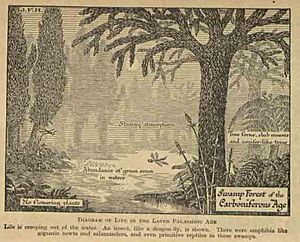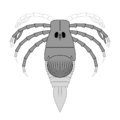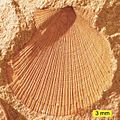Carboniferous facts for kids
The Carboniferous was a time in Earth's history, lasting from about 359 to 299 million years ago. It came after the Devonian period and before the Permian period. It's the fifth period of the Paleozoic era, which is a major division of the Phanerozoic eon (a very long stretch of time).
In the United States, the Carboniferous is split into two parts: the Mississippian (the earlier part, from 359 to 323.2 million years ago) and the Pennsylvanian (the later part, from 323.2 to 299 million years ago). In Europe, people often use the terms lower, middle, and upper Carboniferous.
Amazing Animal Evolution
During the Carboniferous period, some really important changes happened in animal life. Early four-legged animals, called tetrapods, began to split into two main groups.
One group was the amphibians. These animals laid their eggs in water, just like frogs and salamanders do today.
The other group was the amniotes. These animals were special because they laid their eggs on land. Their eggs had a tough shell that protected the baby inside, keeping it from drying out. This was a huge step!
The amniotes then split into two more groups:
- The synapsids: These animals eventually evolved into mammals.
- The sauropsids: These animals eventually evolved into dinosaurs and other reptiles.
These big changes happened early in the Carboniferous period, during the Mississippian time.
The Age of Coal Forests
The Carboniferous period gets its name from the huge amounts of coal that formed during this time. Coal comes from the remains of thick, tropical wetland forests. These forests were like giant swamps.
New types of vascular plants (plants with tubes to carry water and nutrients) grew in these forests. Many of these plants had very thick bark. A lot of the coal we use today came from this ancient bark. These amazing forests grew during the later part of the Carboniferous, called the Pennsylvanian, from about 315 to 300 million years ago.
These ancient forests were located near the equator. The wetlands stretched across a huge ancient supercontinent called Laurussia. This landmass included what is now North America in the west, through parts of Europe, and all the way to China in the east. Imagine a river plain that was 5,000 kilometers long (from eastern Canada to Ukraine) and 700 kilometers wide!
While there's no exact match today, you can get an idea of these forests by looking at peat swamp forests in Indonesia and Malaysia. Also, the Amazon Basin, the Mississippi River system, and the Okefenokee swamp give us clues.
The Carboniferous swamps were mostly filled with giant clubmosses, like Lepidodendron. These were some of the earliest trees on Earth. Later, they were replaced by conifers (like pine trees) and flowering plants. Sometimes, other plants from higher ground, like horsetails, ferns, and tree-like pteridosperms, would get washed into the swamps by rivers.
The huge wetland forests eventually ended when the land started to rise. This happened because the Gondwana continent was pushing against Laurussia. This pressure caused the land where they met to lift up. The end of these coal-forming forests marks the end of the Carboniferous period in many places. However, China was too far away to be affected, so its wetland forests continued for another 50 million years, into the Permian period.
Images for kids
-
Generalized geographic map of the United States in Middle Pennsylvanian time
-
Lower Carboniferous marble in Big Cottonwood Canyon, Wasatch Mountains, Utah
-
Ancient in situ lycopsid, probably Sigillaria, with attached stigmarian roots
-
Base of a lycopsid showing connection with bifurcating stigmarian roots
-
Aviculopecten subcardiformis; a bivalve from the Logan Formation (Lower Carboniferous) of Wooster, Ohio (external mold)
-
Syringothyris sp.; a spiriferid brachiopod from the Logan Formation (Lower Carboniferous) of Wooster, Ohio (internal mold)
-
Palaeophycus ichnosp.; a trace fossil from the Logan Formation (Lower Carboniferous) of Wooster, Ohio
-
The late Carboniferous giant dragonfly-like insect Meganeura grew to wingspans of 75 cm (2 ft 6 in).
-
Mazothairos was a large palaeodictyopteran insect from Mazon Creek.
-
Helenodora inopinata, a Stem-group onychophoran known from Indiana
-
Akmonistion of the Holocephali order Symmoriida roamed the oceans of the early Carboniferous.
-
Dracopristis was a Ctenacanthiform elasmobranch from the late Carboniferous of New Mexico.
-
Allenypterus was a Coelacanth fish known from the Bear Gulch Limestone in Montana.
-
A fossil of Echinochimaera, a fish known from the Bear Gulch Limestone in Montana
-
Phanerosteon was a Bony fish belonging to the extinct order Palaeonisciformes.
-
Rhizodus was a large freshwater Rhizodont sarcopterygian from Europe and North America.
-
Squatinactis, a genus of Elasmobranch fish from Montana
-
The amphibian-like Pederpes, the most primitive tetrapod found in the Mississippian, and known from Scotland.
-
Hylonomus, the earliest sauropsid reptile, appeared in the Pennsylvanian, and is known from the Joggins Formation in Nova Scotia, and possibly New Brunswick.
-
Petrolacosaurus, the earliest known diapsid reptile, lived during the late Carboniferous.
-
Archaeothyris is the oldest known synapsid, and is found in rocks from Nova Scotia.
-
Coloraderpeton was a snake-like aïstopod tetrapodomorph from the late Carboniferous of Colorado.
-
Crassygyrinus was a carnivorous stem-tetrapod from the early Carboniferous of Scotland.
-
Microbrachis was a lepospondyl amphibian known from the Czech Republic.
-
Amphibamus was a dissorophoid temnospondyl from the Late Carboniferous of Illinois.
See also
 In Spanish: Carbonífero para niños
In Spanish: Carbonífero para niños


































